History of the Common Security and Defence Policy
Part of a series on the |
||||||||||||||||||||||||
|---|---|---|---|---|---|---|---|---|---|---|---|---|---|---|---|---|---|---|---|---|---|---|---|---|
| History of the European Union |
||||||||||||||||||||||||
 | ||||||||||||||||||||||||
|
Organisation
|
||||||||||||||||||||||||
|
||||||||||||||||||||||||
|
||||||||||||||||||||||||
|
| ||||||||||||||||||||||||
This article outlines the history of the Common Security and Defence Policy (CSDP) of the European Union (EU), a part of the Common Foreign and Security Policy (CFSP).
The post-war period saw several short-lived or ill-fated initiatives for European defence integration intended to protect against potential Soviet or German aggression: The Western Union and the proposed European Defence Community were respectively cannibalised by the North Atlantic Treaty Organisation (NATO) and rejected by the French Parliament. The largely dormant Western European Union (WEU) succeeded the Western Union's remainder in 1954. In 1970 the European Political Cooperation (EPC) brought about the European Communities' initial foreign policy coordination, which in turn was replaced by the newly founded EU's CFSP pillar in 1993. The WEU was reactivated in 1984 and given new tasks, and in 1996 NATO agreed to let it develop a European Security and Defence Identity (ESDI).[1] The 1998 St. Malo declaration signalled that the traditionally hesitant United Kingdom was prepared to provide the EU with autonomous defence structures.[2] This facilitated the transformation of the ESDI into the European Security and Defence Policy (ESDP) in 1999, when it was transferred to the EU. In 2003 the EU deployed its first CSDP missions, and adopted the European Security Strategy identifying common threats and objectives. In 2009, the Treaty of Lisbon introduced the present name, CSDP, while establishing the EEAS, the mutual defence clause and enabling a subset of member states to pursue defence integration within PESCO. In 2011 the WEU, whose tasks had been transferred to the EU, was dissolved. In 2016 a new security strategy was introduced, which along with the Russian annexation of Crimea, the scheduled British withdrawal from the EU and the election of Trump as US President have given the CSDP a new impetus.
1945 – 1950: From Franco-British alliance to Western Union
On 4 March 1947 France and the United Kingdom signed the Treaty of Dunkirk for mutual assistance in the event of a possible German or Soviet attack in the aftermath of World War II. The treaty entered into force on 8 September 1947.
In March 1948 the Treaty of Dunkirk was in essence succeeded by Article 4 of the Treaty of Brussels, to which the Benelux countries were also party. In September the same year the Western Union (WU) was established to implement the Treaty of Brussels, with an allied European command structure under British Field Marshal Montgomery. The military arm of the WU was referred to as the Western Union Defence Organisation (WUDO).
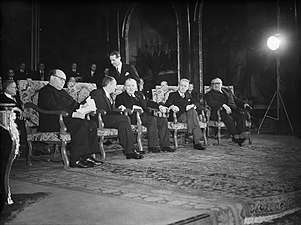 Foreign ministers of the five European powers at the signing of the Treaty of Brussels
Foreign ministers of the five European powers at the signing of the Treaty of Brussels Organisational chart of the Western Union as of November 1948
Organisational chart of the Western Union as of November 1948 British military police displaying the Western Union Standard
British military police displaying the Western Union Standard The high-level headquarters of Chairman Montgomery of the Western Union C-in-C Committee, situated in Château des Fougères in Fontainebleau's neighbouring commune Avon
The high-level headquarters of Chairman Montgomery of the Western Union C-in-C Committee, situated in Château des Fougères in Fontainebleau's neighbouring commune Avon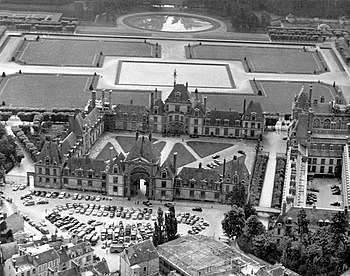 Western Union air, sea and land commands, situated in the Henry IV quarter at the Palace of Fontainebleau
Western Union air, sea and land commands, situated in the Henry IV quarter at the Palace of Fontainebleau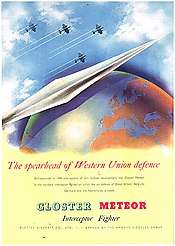 1949 poster advertising the Gloster Meteor jet fighter as the spearhead of Western Union defence
1949 poster advertising the Gloster Meteor jet fighter as the spearhead of Western Union defence
1950 – 1952: NATO cannibalises the Western Union
When the division of Europe into two opposing camps became considered unavoidable, the threat of the USSR became much more important than the threat of German rearmament. Western Europe, therefore, sought a new mutual defence pact involving the United States, a powerful military force for such an alliance. The United States, concerned with containing the influence of the USSR, was responsive. Secret meetings began by the end of March 1949 between American, Canadian and British officials to initiate the negotiations that led to the signing of the North Atlantic Treaty on 4 April 1949 in Washington, DC.
The need to back up the commitments of the North Atlantic Treaty with appropriate political and military structures led to the creation of the North Atlantic Treaty Organisation (NATO). In December 1950, with the appointment of General Eisenhower as the first Supreme Allied Commander Europe (SACEUR), the members of the Treaty of Brussels decided to transfer the headquarters, personnel, and plans of the Western Union Military Organisation (WUDO) to NATO.[3] NATO's Supreme Headquarters Allied Powers Europe (SHAPE) took over responsibility for the defence of Western Europe, while the physical headquarters in Fontainebleau were transformed into NATO's Headquarters, Allied Forces Central Europe (AFCENT).[4][5][6][7]
As WUDO's capacities were transferred to NATO's SHAPE, Field Marshal Bernard Montgomery resigned as Commanders-in-Chief Committee Chairman on 31 March 1951 and took the position of deputy Supreme Allied Commander Europe (SACEUR) on 1 April 1951.
The establishment of NATO, along with the signing of a succession of treaties establishing the Organisation for European Economic Cooperation (April 1948), the North Atlantic Treaty Organisation (April 1949), the Council of Europe (May 1949) and the European Coal and Steel Community (April 1951), left the Western Union and its founding Treaty of Brussels was left devoid of much of its authority.
1952 – 1954: The European Defence Community fails
Since the end of World War II, West Germany had been occupied by Allied forces and lacked its own means of defense. On 23 July 1952, the European Coal and Steel Community (ECSC) came into existence, bonding the member states economically. By 1951, fear of possible Soviet aggression in Europe, as well as the Pleven plan, proposed in 1950 by then French Prime Minister René Pleven in response to the American call for the rearmament of West Germany, led France, West Germany, Italy and the Benelux – the Inner six of European integration – to propose a scheme that was similar in nature to the ECSC but concerned defence; the European Defense Community (EDC). The EDC would have consisted of a pan-European military divided into national components, with a common budget, common institutions, common arms and centralised procurement. At the time, this was favoured over admitting Germany to NATO. The General Treaty (German: Deutschlandvertrag) of 1952 formally named the EDC as a prerequisite of the end of Allied occupation of Germany. The EDC founding treaty did not enter into force, however, as it failed to obtain approval for ratification on 30 August 1954 in the French National Assembly where Gaullists feared for national sovereignty and Communists opposed a European military consolidation that could rival the Soviet Union.
 Organisational chart planned for the European Defence Community
Organisational chart planned for the European Defence Community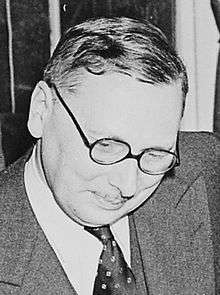 French Prime Minister René Pleven (1951)
French Prime Minister René Pleven (1951)
1954 – 1970: A dormant WEU is established
The failure to establish the EDC resulted in the 1954 amendment of the Treaty of Brussels at the London and Paris Conferences which in replacement of EDC established the political Western European Union (WEU) out of the Western Union. While the WEU was not as broad or powerful as the previously proposed EDC, it was nevertheless sufficient for the Deutschlandvertrag to come into force and therefore to end the occupation of West Germany, give it full sovereignty and admit it as an ally in the Cold War, both in the WEU and NATO. Italy was also admitted in these organisations. From this point defence aims had shifted to the Soviet Union.
On 1 January 1960, in accordance with a decision taken on 21 October the previous year by the Council of Western European Union and with Resolution(59)23 adopted on 16th November 1959 by the Committee of Ministers of the Council of Europe, the WEU activities in social and cultural areas (Social Committee, Public Health Committee, Joint Committee on the Rehabilitation and Resettlement of the Disabled and Cultural Committee) were transferred to the Council of Europe, which was already running programmes in these fields. The European Universities Committee (see CM(60)4; C(59)127 and CM(59)130) was transferred to the Council of Europe separately from the rest of WEU cultural activities.[8]
1970 – 1984: Initial foreign policy coordination
In the 1950s and 1960s, the EEC member states tried twice to give the internal market a foreign policy dimension but failed on both attempts. Efforts to pursue such integration were impeded by concerns relating to national sovereignty as well as potential duplication of NATO's role.
In 1970 the European Political Cooperation (EPC) was introduced as an initial coordination of foreign policy within the EC. The involvement of the United Kingdom guaranteed its Atlanticist nature. Although the EPC was mainly intergovernmental, the European Commission would be able to express its opinion if matters within its competencies were concerned. The EPC was amended and strengthened in the so-called Copenhagen and London reports in 1973 and 1981, respectively, and codified (formalised) in 1986 with the Single European Act.
Although the EPC made the Europeean Communities an active player on the international scene during the 1970s, notably in the Middle East conflict and in the creation of the Conference on Security and Co-operation in Europe, it was considered a mixed success.
1984 – 1998: WEU reactivated, EU established
From the late 1970s onwards, efforts were made to add a security dimension to the EC's EPC. Opposition to these efforts from Denmark, Greece and Ireland led the remaining EC countries - all WEU members - to reactivate the WEU in 1984.[9]
In 1992, the WEU adopted the Petersberg Declaration, defining the so-called Petersberg tasks designed to cope with the possible destabilising of Eastern Europe. The WEU itself had no standing army but depended on cooperation between its members. Its tasks ranged from the most modest to the most robust, and included Humanitarian, rescue and peacekeeping tasks as well as tasks for combat forces in crisis management, including peacemaking.[10]
Upon the entry into force of the Maastricht Treaty in 1993, the European Union was established, consisting of three pillars, of which the first was the European Communities, one was the Common Foreign and Security Policy (CFSP) - a replacement of the European Communities' EPC - and the last was the Justice and Home Affairs (JHA). The CFSP pillar became a natural basis for a further deepening of EU defence policy cooperation.
At the 1996 NATO ministerial meeting in Berlin, it was agreed that the WEU would oversee the creation of a European Security and Defence Identity (ESDI) within NATO structures.[11] The ESDI was intended as a European 'pillar' within NATO, partly to allow European countries to act militarily where NATO wished not to, and partly to alleviate the United States' financial burden of maintaining military bases in Europe, which it had done since the Cold War. The Berlin agreement allowed European countries (through the WEU) to use NATO assets if it so wished.
- Hotel Petersberg, where the Petersberg tasks were defined in 1992.
.svg.png) Flag of the Western European Union (1993–1995)
Flag of the Western European Union (1993–1995) Flag of the Western European Union (1995–2011)
Flag of the Western European Union (1995–2011)
1998 – 2009: EU takes over WEU tasks, gains autonomous structures

On 4 December 1998 the United Kingdom, which had traditionally opposed the introduction of European autonomous defence capacities, signed the Saint-Malo declaration together with France.
| “ | [...] the Union must have the capacity for autonomous action, backed up by credible military forces, the means to decide to use them, and a readiness to do so, in order to respond to international crises. | ” |
| — Saint-Malo declaration, 4 December 1998[12] | ||
This marked a turning point as the declaration endorsed the creation of a European security and defense policy, including a European military force capable of autonomous action.[13] The declaration was a response to the Kosovo War in the late 1990s, in which the EU was perceived to have failed to intervene to stop the conflict.[14]
Following the establishment of the ESDI and the St. Malo declaration, US Secretary of State Madeleine Albright were among others who voiced concern that an independent European security pillar could undermine NATO, as she put forth the three famous D's:
| “ | Our [...] task is working together to develop [the ESDI] within [NATO], which the United States has strongly endorsed. We enthusiastically support any such measures that enhance European capabilities. The United States welcomes a more capable European partner, with modern, flexible military forces capable of putting out fires in Europe's own back yard and working with us through [NATO] to defend our common interests. The key to a successful initiative is to focus on practical military capabilities. Any initiative must avoid preempting [NATO] decision-making by de-linking ESDI from NATO, avoid duplicating existing efforts, and avoid discriminating against non-EU members. [...] | ” |
| — US Secretary of State Albright, North Atlantic Council (8 December 1998)[15] | ||
As a direct consequence of the Saint-Malo summit, the EU formulated a "Headline Goal" in Helsinki in 1999, setting 2003 as a target date for the creation of a European force of up to 60,000 troops, and establishing a catalogue of forces, the 'Helsinki Force Catalogue', to be able to carry out the so-called "Petersberg Tasks".

The Treaty of Amsterdam, which entered into force in 1999, transferred the WEU's Petersberg tasks to the EU, and stated that the EU's European Security and Defence Policy (ESDP), replacing the WEU's ESDI, would be 'progressively framed' on the basis of these tasks.
In June 1999, the Cologne European Council decided to incorporate the role of the WEU within the EU, effectively abandoning the WEU. The Cologne Council also appointed Javier Solana as the High Representative for Common Foreign and Security Policy to help progress both the CFSP and the ESDP.
In 2000 and 2001 a number of ESDP bodies were established within the EU Council, including the Political and Security Committee (PSC), the Military Committee (EUMC) and the Military Staff (EUMS).
In 2002 the European Union Satellite Centre superseded the Western European Union Satellite Centre, and the 1996 Berlin agreement was amended with the so-called Berlin Plus agreement, which allowed the EU to also draw on some of NATO's assets in its own peacekeeping operations, subject to a "right of first refusal" in that NATO must first decline to intervene in a given crisis. Additionally, an agreement was signed on information sharing between the EU and NATO, and EU liaison cells were addet at NATO's Supreme Headquarters Allied Powers Europe (SHAPE) and Joint Force Command (JFC) in Naples.
In 2003 the Treaty of Nice entered into force, providing the ESDP's legal foundation in terms of competences, organisation, structures and assets. The same year the ESDP became operational through its first missions and operations, and the EU adopted its European Security Strategy, outlining common threats and objectives.[16] The European security strategy was for the first time drawn up in 2003 under the authority of the EU's High Representative for the Common Foreign and Security Policy, Javier Solana, and adopted by the Brussels European Council of 12 and 13 December 2003. With the emergence of the ESDP, it was the first time that Europe had formulated a joint security strategy. It could be considered a counterpart to the National Security Strategy of the United States.
It became clear that the objectives of the outlined in the Helsinki Headline Goal were not achievable quickly. In May 2004, EU defence ministers approved "Headline Goal 2010", extending the timelines for the EU's projects. However, it became clear that the objectives cannot be achieved by this date too. French Foreign Minister Alain Juppé espressed his desperation: "The common security and defense policy of Europe? It is dead."[17][18]
In 2004 the European Defence Agency (EDA) was established to facilitate defence integration.
In 2005 the EU Battlegroups (BG) initiative was operational as a result of the Helsinki Headline Goal process. Each battlegroup were to quickly be able to deploy about 1,500 personnel.[19]
2009 – 2015: Deeper cooperation enabled, WEU dissolved
.jpg)
Upon the entry into force of the Treaty of Lisbon in 2009 the ESDP was renamed the Common Security and Defence Policy (CSDP), a mutual defence clause was introduced among member states and a subset of willing member states fulfilling 'higher criteria' were allowed to pursue Permanent Structured Cooperation (PESCO). The post of High Representative of the Union for Foreign Affairs and Security Policy also superseded the two previous posts of High Representative for the Common Foreign and Security Policy and European Commissioner for External Relations. The treaty also led to the dissolution of the Western European Union in 2011 as, with the solidarity clause (deemed to supersede the WEU's military mutual defence clause) and the expansion of the CSDP, the WEU became redundant.
2015 – present: New political impetus, structural integration
The mutual defence clause, Article 42.7, was invoked for the first time in November 2015 following the terrorist attacks in Paris, which were described by French President François Hollande as an attack against Europe as a whole.[20][21]
In 2016 HR/VP Federica Mogherini drew up a new security strategy, the European Union Global Strategy, which along with the Russian annexation of Crimea, the scheduled British withdrawal from the EU and the election of Donald Trump as US President have given the CSDP a new impetus.
This has given rise to a number of initiatives:
- Permanent Structured Cooperation (PESCO; 2017–)
- Coordinated Annual Review on Defence (CARD; 2019-)
- European Defence Fund (EDF; 2017)
- Military Planning and Conduct Capability (MPCC; 2017)
The MPCC is a part of the External Action Service's Military Staff (EUMS) that constitutes the EU's first permanent operational headquarters. The Director General of the EUMS also serves as Director of the MPCC - exercising command and control over the operations within the MPCC's remit.
Timeline
Abbreviations:
- CFSP: Common Foreign and Security Policy
- CoE: Council of Europe
- CSDP: Common Security and Defence Policy
- EDC: European Defence Community
- EI2: European Intervention Initiative
- EPC: European Political Cooperation
- ESDI: European Security and Defence Identity
- ESDP: European Security and Defence Policy
- EU: European Union
- NATO: North Atlantic Treaty Organisation
- PESCO: Permanent Structured Cooperation
- UK: United Kingdom
- WEU: Western European Union
- WU: Western Union
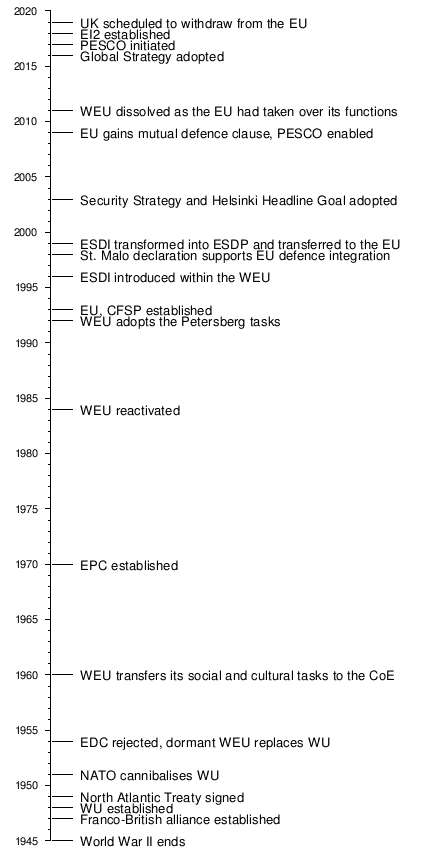
See also
- List of military and civilian missions of the European Union
- History of the Common Foreign and Security Policy
- History of the European Union
- Military history of Europe
- History of the North Atlantic Treaty Organization
Major CSDP office-holders:
- List of High Representatives
- List of Chairmen of the European Union Military Committee
- List of Directors General of the European Union Military Staff
History of military precursors of the European Union:
Other:
- Scandinavian defence union (proposed in the post-war period)
References
- ↑ https://eur-lex.europa.eu/summary/glossary/european_security_defence_identity.html
- ↑ https://euobserver.com/foreign/138147
- ↑ Hansard extract February 18, 1957
- ↑ Duke, Simon (2000). The elusive quest for European security: from EDC to CFSP. Basingstoke, UK: Palgrave Macmillan. pp. 13–14. ISBN 978-0-312-22402-8. Retrieved 2010-11-27.
- ↑ "Did you know that Europe already had a defensive military alliance prior to NATO?". Allied Command Operations (ACO). NATO. 2010. Retrieved 2010-08-08.
- ↑ Kaplan, Lawrence S. NATO 1948: the birth of the transatlantic Alliance. Lanham, Maryland: Rowman & Littlefield Publishers, Inc. pp. 139–165. ISBN 0-7425-3917-2. Retrieved 2010-08-08.
- ↑ "Brussels Treaty Organisation (Resolution)". Hansard. London: House of Commons of the United Kingdom. 565. 18 February 1957. cc19-20W. Retrieved 2010-11-27.
- ↑ https://www.coe.int/en/web/documents-records-archives-information/timeline-1948#{"19133186":[0]}
- ↑ https://www.bbc.co.uk/news/special/politics97/news/06/0616/jargon.shtml
- ↑ EUROPA – Glossary – Petersberg tasks
- ↑ NATO Ministerial Meetings Berlin – 3–4 June 1996
- ↑ https://www.cvce.eu/content/publication/2008/3/31/f3cd16fb-fc37-4d52-936f-c8e9bc80f24f/publishable_en.pdf
- ↑ "Franco–British St. Malo Declaration (4 December 1998)". Retrieved 2015-08-18.
- ↑ Adam. "The Saint-Malo Declaration and its impact on ESDP after 10 years - Defence Viewpoints from UK Defence Forum". www.defenceviewpoints.co.uk. Retrieved 2015-08-18.
- ↑ https://1997-2001.state.gov/statements/1998/981208.html
- ↑ "European security strategy", SCADPLUS, September 4, 2006
- ↑ Meltem Mueftueler-Bac & Damla Cihangir, "The Transatlantic Relationship and the Future Global Governance", European Integration and Transatlantic Relations, (2012), p 12, www.iai.it/pdf/Transworld/TW_WP_05.pdf
- ↑ "Presidency Conclusions. Helsinki European Council 10 and 11 December 1999". www.consilium.europa.eu. Retrieved 2015-08-18.
- ↑ Council of the European Union (July 2009). "EU BATTLEGROUPS" (PDF). Europa web portal. Retrieved 3 June 2013.
- ↑ Peter Spiegel in Brussels and Jim Brunsden in Paris (2015-11-16). "Hollande makes unusual appeal to EU collective defence article - FT.com". M.ft.com. Retrieved 2016-02-19.
- ↑ Source: CNNAdded on 1418 GMT (2218 HKT) November 16, 2015 (2015-11-16). "Francois Hollande: 'France is at war' – CNN Video". Edition.cnn.com. Retrieved 2016-02-19.
External links
- Shaping of a Common Security and Defence Policy, European External Action Service
- Timeline: EU cooperation on security and defence, Council of the European Union
- The organisation of post-war defence in Europe (1948–1954), European Navigator
- History of European defence integration, European Defence Agency
- Chronology - Europe's long road in search of a common defence, Reuters